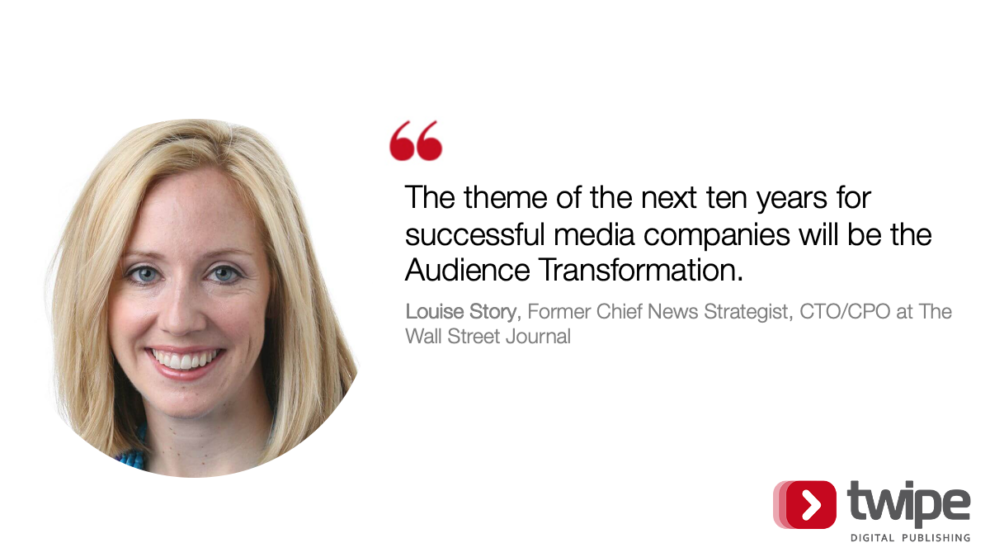The News Industry has to Stop Talking about “Digital Transformation”

Written by Louise Story former Chief News Strategist and Chief Product and Technology Officer at The Wall Street Journal
The digital revolution began around the year 1980. The shift from analog electronics to digital technology has dramatically changed the way most industries work and, importantly, the way we all interact with content and products. And that’s been the case for a long time now.
So why are so many news organizations still talking about digital transformation? Why are they talking about what they can do to “digitize” their content?
The answer is because they are far too focused on their content, and not on their audiences.
The theme of the next ten years for successful media companies will be the Audience Transformation. In this period, audience preferences and interests will rise significantly in the equation of what content is produced. At a news company, after all, the content is the product, and so you can’t have product thinking at one end of the building while reporters and editors plow forward on the other side.
Practically speaking, how is this done? Here are a few steps that news organizations can take right now to be sure they are situated to create content that audiences value.

1. Wall Off Your Legacy Operation
If your newsroom produces a print product or a television show or a radio broadcast —- anything that is one-way, legacy media — you must separate that product and the team that creates it from the main part of your newsroom where reporters and editors should be focusing only on what is working with audiences on the Internet. Making this separation can require some investment, because you may have to add people to your print or television operation in order to fully wall it off, but it is simply essential. Without doing it, you will not be able to shift your teams’ focus from the old patterns of their old mediums.
2. Examine Your Metrics of Success
Most newsrooms are looking at data of some sort to understand their audience habits. But too many metrics lack nuance and don’t point towards business goals. Are you looking at engaged time, for instance, but failing to differentiate by story length? Are you looking at page views, for instance, but ignoring who those page views are coming from and whether they are a growth audience? Sit down with a cross-disciplinary team and do a deep dive on what data you’re getting, what data you are not collecting (and why) and which metrics you can develop that will ladder up to what you are trying to achieve.
3. Start Listening More
Newsrooms aren’t traditionally built on a culture of listening, but they need to be. Happily, media companies are hiring more people with technology, design and product backgrounds. Traditional editors should listen to these folks and learn how the technology culture encourages listening, testing and learning as part of every day operations. This is an essential part of the Audience Transformation, and it’s also essential in terms of employee leadership. There is a generational shift away from the autocratic, top-down, punch-list style of leadership that has dominated the media in the past.
4. Don’t Be Snobby
Too many people in our industry look down at utility-oriented content. “That’s not what we do!” is a common phrase. If you know me well, you know I am one of the biggest proponents of long-form, investigative and traditional great stories. But I am also a big believer in offering the audience a buffet of content types and flexing many different muscles as a journalist. As newsrooms go through the Audience Transformation, and look to data and other methods of feedback and listening, they will find there is a need from audiences for basic, useful information.
The news industry has ceded too much of that to technology companies and must find ways to productize, habit-forming new features that make people’s lives easier. One quick example? Turbovax, a website founded by a single developer in NYC to help people find vaccine appointments. This is something news sites could have done — beyond showing data about the spread of covid, news sites could have helped people find vaccination appointments. I don’t think I’m the only person who had a few weeks of massive habituation on Turbovax!
Don’t miss your chance to hear more from Louise at our Digital Growth Summit happening 27th-28th September!
Louise is the former Chief News Strategist and Chief Product and Technology Officer at The Wall Street Journal, where she led all news coverage strategy as well as brand-wide product development. Before that, she worked at The New York Times for 11 years in roles ranging from investigative reporting to running the Times’ live video operation to creating company strategic plans. She is currently writing a book about race and money in America.
Other Blog Posts

Stay on top of the game
Join our community of industry leaders. Get insights, best practices, case studies, and access to our events.
"(Required)" indicates required fields


